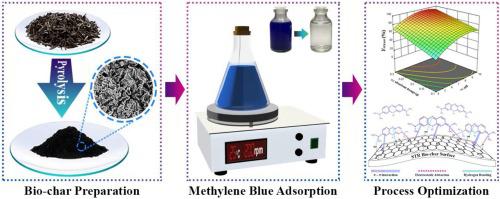Chemical Engineering and Processing: Process Intensification ( IF 4.3 ) Pub Date : 2020-10-10 , DOI: 10.1016/j.cep.2020.108170 Ehsan Salehi , Mahdi Askari , Mohammad Velashjerdi , Behzad Arab

|
This work investigates the production of biochars from phosphoric acid-treated spent-tea residue (STR) by pyrolysis at different temperatures. The biochar morphology and chemistry were characterized via SEM, FT-IR, XRD and BET analyses. Results showed that an increase in the pyrolysis temperature could enhance the porous-structure and increase the surface area, whereas it might deteriorate the surface-functional groups to some extent. The produced biochar samples were employed for the adsorption of methylene blue (MB) from water. The batch adsorption process was investigated via a data-based multivariate optimization approach, Pareto sensitivity analysis and response surface methodology (RSM) for the intensification of the process. The STR biochar produced at the pyrolysis temperature of 400 °C offered the maximum MB removal of 99.26% at the optimal operating conditions of pH = 9.65, initial dye concentration = 81.24 mg/L, adsorbent dosage = 0.26 g and contact time = 97.92 min. Pareto sensitivity analysis revealed that the MB adsorption on STR-derived biochar is strongly influenced by pH and contact time. The isothermal and kinetic studies indicated that the adsorption of MB on STR biochar is well described by the Langmuir isotherm and pseudo-second order model, respectively. The adsorption capacity of the optimal biochar was obtained to be 91.13 mg/g.
中文翻译:

磷酸处理的废茶叶残渣生物炭用于废水脱色:使用基于数据的多元优化进行批量吸附研究和工艺强化
这项工作研究了在不同温度下通过热解由磷酸处理过的茶残渣(STR)产生生物炭的方法。通过SEM,FT-IR,XRD和BET分析表征了生物炭的形态和化学性质。结果表明,热解温度的升高可以增强多孔结构并增加表面积,而在一定程度上可能会使表面官能团变质。产生的生物炭样品用于从水中吸附亚甲基蓝(MB)。通过基于数据的多元优化方法,帕累托灵敏度分析和响应面方法(RSM)对间歇吸附过程进行了研究,以增强过程。在400°C的热解温度下产生的STR生物炭提供的最大MB去除量为99。在最佳操作条件下,pH = 9.65,初始染料浓度= 81.24 mg / L,吸附剂剂量= 0.26 g,接触时间= 97.92分钟,脱硫率为26%。帕累托敏感性分析表明,MB吸附在STR衍生的生物炭上受到pH和接触时间的强烈影响。等温和动力学研究表明,Langmuir等温线和伪二级模型分别很好地描述了MB在STR生物炭上的吸附。最佳生物炭的吸附容量为91.13 mg / g。等温和动力学研究表明,Langmuir等温线和伪二级模型分别很好地描述了MB在STR生物炭上的吸附。最佳生物炭的吸附容量为91.13 mg / g。等温和动力学研究表明,Langmuir等温线和伪二级模型分别很好地描述了MB在STR生物炭上的吸附。最佳生物炭的吸附容量为91.13 mg / g。


























 京公网安备 11010802027423号
京公网安备 11010802027423号